|
|
 |
| SW Aviator Magazine is available in print free at FBOs and aviation-related businesses throughout the Southwest or by subscription. |

|
 |

|
 |
 |
 |
|
The web's most comprehensive database of Southwest area aviation events.
|

|
 |

|
 |
|
Featured Site:
|
|
|
 |
|
A continuosly changing collection of links to our favorite aviation related web sites.
|

|
 |

|
 |

|
 |
Search by:

|
|
|
Or enter a keword:

|
|
|
Post a FREE Classified Ad 
|
 |
|

|
How Low can You go?
|
|
Death Valley National Park, California
|
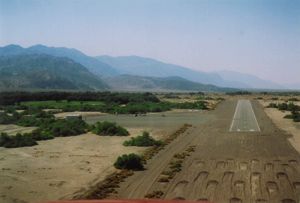
By Gerrit Paulsen
Photos by Gerrit & Cindy Paulsen
We’ve hit an all-time low in our flying career. Absolutely rock bottom. The pits. Reaching these depths, however, was cause for celebration, since it marked both the realization of a flying career milestone, and our arrival at one of the Southwest’s best fly-in destinations.
On final approach for landing at the Furnace Creek Airport, at the bottom of California’s Death Valley National Park, we watched our altimeter wind down past 100 feet MSL, to 50 feet, to zero, and then continue below sea level – minus 100, minus 200, and sill dropping!
At minus 210 feet, Furnace Creek is the lowest airport in the US, and landing here is a milestone in every pilot’s aviation career. However, this isolated destination has far more to offer visitors that just checking off a “been there done that” square. The airstrip is the gateway to enjoying the refined amenities of the adjacent Furnace Creek Inn and Ranch Resort, and the stark beauty of Death Valley that surrounds it. Luxurious accommodations, fabulous meals, golf, swimming, and the unending panoramas of Death Valley await those willing to sink this low.
Furnace Creek was originally founded as a working ranch in the 1880s, and later became home to the famous 20-mule teams of the Pacific Coast Borax Company. In the early 1920s, increased public interest in Death Valley prompted Pacific Coast Borax to enter the tourism business. Following the lead of the successful Palm Springs Desert Inn, the company began building a magnificent Inn for guests to enjoy the rare beauty of Death Valley. The Furnace Creek Inn opened on February 1, 1927, though construction continued for nearly a decade until its completion with 66 rooms in 1935. To mark its 75th Anniversary, the AAA four-diamond rated Inn has been renovated to a 1930s look, making the hotel as impressive today as it was the day it opened.
The Inn is located two miles up the road from the airstrip (which is an integral part of the resort property). Prompt courtesy shuttle service links all the resort’s lodgings and activities, including the airport, just pick up the phone in the pilot’s lounge at the parking ramp (760-786-2345). The courtesy van was already on the on the ramp as we taxied in, dropping off a couple from Riverside at their C-182. The van driver cheerfully helped us transfer our bags from the plane, assisted us in navigating the somewhat convoluted system of refueling the aircraft (see sidebar), and then helped tie down the airplane. After stopping at a bright purple King Air to add a trio of Hollywood-types to the van, we were off to the Inn. The Beautiful People told us they had flown in from Burbank just to enjoy the Inn’s famous Sunday Brunch. We too, had timed our arrival to partake in this legendary feast.
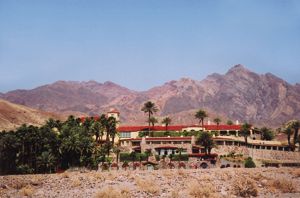 The Furnace Creek Inn is dramatically situated at the edge of the valley, nestled against the Funeral Mountains, overlooking the desert salt pans and majestic 11,000-foot Panamint Mountains beyond. Just before turning onto the Inn’s driveway, we passed a road sign announcing we had climbed back up to sea level. The mission style Inn, with its Moorish influenced stonework and handmade adobe bricks, looks at home in this harsh desert setting. The oasis-like feel of the property is enhanced by an abundance of towering palm trees and green, shady gardens surrounding the hotel. The Furnace Creek Inn is dramatically situated at the edge of the valley, nestled against the Funeral Mountains, overlooking the desert salt pans and majestic 11,000-foot Panamint Mountains beyond. Just before turning onto the Inn’s driveway, we passed a road sign announcing we had climbed back up to sea level. The mission style Inn, with its Moorish influenced stonework and handmade adobe bricks, looks at home in this harsh desert setting. The oasis-like feel of the property is enhanced by an abundance of towering palm trees and green, shady gardens surrounding the hotel.
Despite the relatively early morning hour, our room was ready when we arrived. The rooms at the Inn are luxurious, and have all been recently refurbished and redecorated. All rooms feature air conditioning and ceiling fans, televisions (with pay movies and free HBO), telephones, refrigerators, hair dryers, and terry robes. Most rooms have decks or terraces, and some rooms have spa tubs. Room rates in high season (mid-October through mid-May) start at $235, in the hot off-season rates start at $155. (For reservations and information call 760-786-2345 or visit www.furnacecreekresort.com.)
While the Furnace Creek Inn was designed as an elegant, world class destination, the nearby Furnace Creek Ranch (adjacent to the airstrip), is a more rustic and affordable alternative for families and adventurers alike. Room rates at the Ranch starts at $117 in season, $102 off-season. The AAA two-diamond Ranch opened in 1932, and was refurbished in 1997. The Ranch provides guests with 224 comfortable guest rooms, situated around the resort’s 18-hole golf course. The Ranch is also home to a general store, the Borax Museum, riding stables, and several restaurants and a saloon. Regardless of where you stay, all the amenities of both the Inn and the Ranch are easily accessible via the Resort’s courtesy van shuttles.
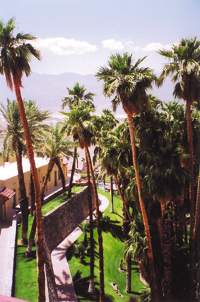
The Furnace Creek Inn’s famed Sunday Brunch is served in the elegant Inn Dining Room. As we brunched, surrounded by windows providing a panoramic view of the Panamint Mountains and the harsh desolation below, we reflected on how lucky we aviators are to effortlessly experience the charm of such fine dining in one of the world’s most remote settings. The Inn Dining Room is also open for breakfast and dinner daily. Lunch and Sunday Brunch are only offered October through May.
We decided to walk off our brunch excesses by exploring the Borax Museum down at the Ranch. The recently renovated museum is maintained and operated by the Resort, and is open to the public free of charge. In addition to providing the history of the property and the key figures involved in the development of Death Valley and the Furnace Creek Resort, artifacts of the past, such as antique stagecoaches, mining tools, and a steam engine are displayed in the museum courtyard. The museum also houses an extensive diary of the immigrants who, in the winter of 1849, coined the term “Death Valley,” after barely surviving five weeks of thirst and starvation crossing this desolate basin while seeking a shorter route to Los Angeles.
Contrary to its dire sounding name, Death Valley is actually a thriving natural environment, home to more than 900 kinds of plants and abundant desert wildlife. The months between October and March are uniformly cool and pleasant, with highs ranging between 68 and 80 degrees, and snow is not uncommon at higher elevations during the winter. The valley, however, only receives about 1.8 inches of rainfall per year.
Recognizing the value of this unique natural landscape, Death Valley National Monument was established in 1933. In 1994 it was re-designated as a National Park, making Death Valley the largest National Park in the continental United States (3,000 square miles). Although tourism was in its infancy here when Pacific Coast Borax began building the Furnace Creek Inn, it boomed when the National Monument designation brought new, paved roads to and throughout valley. In 1956, the Fred Harvey Company, which pioneered hospitality on the railroads carrying Americans to the West, took over the management of the Furnace Creek Inn and Ranch Resort. Amfac (now Xanterra) Parks & Resorts, Inc. acquired the property when they purchased the Fred Harvey Company in 1968.
Another way to work off brunch, or simply enjoy these unique surroundings, is with a round of golf. Situated 214 feet below sea level, the Furnace Creek golf course is the lowest grass course in the world. The original 9-hole course was completed in 1931, making it the first grass golf course in the California desert region. Back then, the resort closed in summer, so the golf course was leased to a rancher who ran about 150 head of cattle on it. Then, during the winter tourist season, a small flock of sheep kept the fairways properly mowed. The course underwent a major renovation in 1997 by world renowned golf architect Perry Dye. Today, the fairways are beautifully lined with palm and tamarisk trees, and breathtaking views of the surrounding mountains are seen from anywhere on the course. (Call 760-786-2301 for information and tee times.)
The golf course is keep green by the same springs that supply all the Resort’s water needs. This includes feeding the outdoor swimming pools at both the Inn and the Ranch. The constant flow from the natural warm springs keeps the pools’ temperatures at a comfortable 82 degrees, and eliminates the need for any chemicals. The Inn’s swimming pool was constructed with views of the surrounding mountains and valley below, and has become the centerpiece of the hotel. After leaving the pool, the spring water feeds streams meandering through the Inn’s world renowned oasis garden, then eventually ends up at the Ranch to irrigate the golf course.
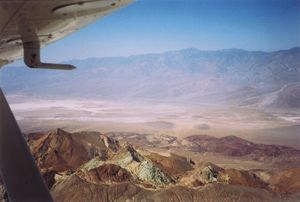 We finished the afternoon lounging around the pool at the Inn, watching the valley’s colors change and become more vibrant as the sun slipped below Telescope Peak. Evenings around the pool are a Furnace Creek tradition, as is watching the myriad of stars visible in the clear, dark night sky from one of the Inn’s spacious verandahs. We finished the afternoon lounging around the pool at the Inn, watching the valley’s colors change and become more vibrant as the sun slipped below Telescope Peak. Evenings around the pool are a Furnace Creek tradition, as is watching the myriad of stars visible in the clear, dark night sky from one of the Inn’s spacious verandahs.
After an early breakfast the next morning, the shuttle driver once again cheerfully loaded our bags into the courtesy van for the short ride back down below sea level to the airstrip. On run up, I double, then tripled checked the altimeter, to be sure I had correctly set minus 210 feet (yes, it looks like 790 feet, but it isn’t). After takeoff, we reluctantly watched the altimeter wind back up into a more natural looking range as we crested MSL. It had been a pleasure being this low, and we hope to hit rock bottom again soon!
|
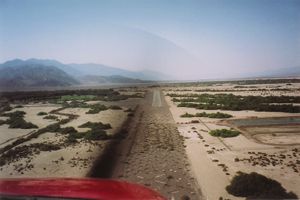
The Death Valley National Park/Furnace Creek airport (L06) is located one mile northwest of the Furnace Creek Ranch. GPS coordinates are N36-27.83 W116-52.88. The Shoshone and Panamint MOAs dominate the airspace above Death Valley, though they exclude the airspace below 3000 feet AGL within the National Park boundaries. Contact the friendly controllers at Joshua Approach (120.25) for courteous flight following through this maze of military airspace. Pilots are requested to maintain 2500 feet AGL minimum over Death Valley. The airport environs are easy to spot, adjacent to the incongruous green expanse of the Furnace Creek golf course. The runway is actually much smaller than it first appears, as the current runway lies within the outline of an old, much larger runway. That runway is now unusable, courtesy of Park Service bulldozers carving huge divots into the old tarmac.
The field elevation of minus 210 feet makes the pattern altitude of 789 feet sound low. CTAF is 122.9. The single, lighted asphalt runway, 15-33, is 3,040 x 70 feet and in good condition. Use right traffic for runway 15 to avoid over flying the Ranch, and National Park Visitor’s Center and campground east of the airport.
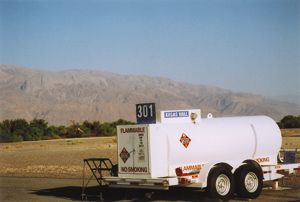 There are tiedown anchor cables on the large parking ramp, but bring your own tiedowns. Fuel is available from a trailer-mounted tank in the tiedown area by contacting the Furnace Creek Chevron Station at the number posted on the tank (760-786-2343). The attendant will then drive down from the gas station to unlock and operate the pump while you work the nozzle to top off the plane. You pay for the fuel at the Chevron Station. The price is rather high ($3.01 on our visit), but its not unreasonable considering the extremely remote location. There are tiedown anchor cables on the large parking ramp, but bring your own tiedowns. Fuel is available from a trailer-mounted tank in the tiedown area by contacting the Furnace Creek Chevron Station at the number posted on the tank (760-786-2343). The attendant will then drive down from the gas station to unlock and operate the pump while you work the nozzle to top off the plane. You pay for the fuel at the Chevron Station. The price is rather high ($3.01 on our visit), but its not unreasonable considering the extremely remote location.
|
Click here to return to the beginning of this article.  |
|